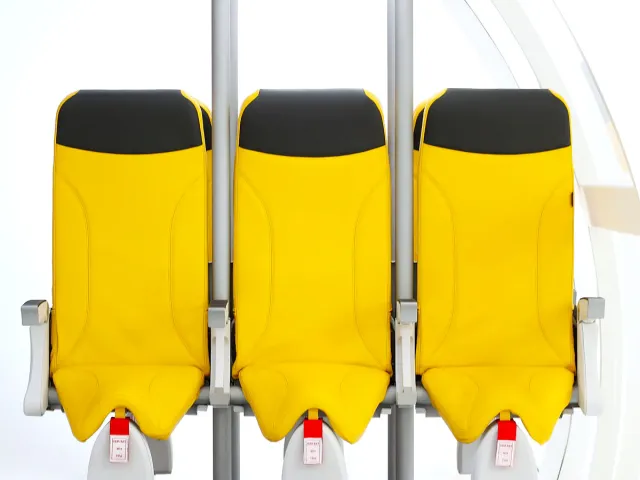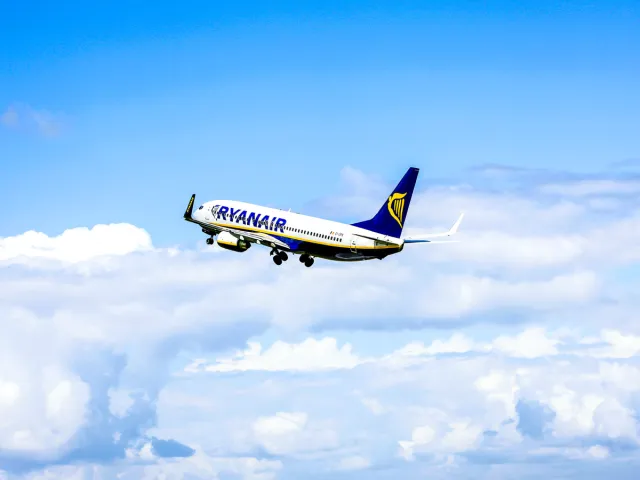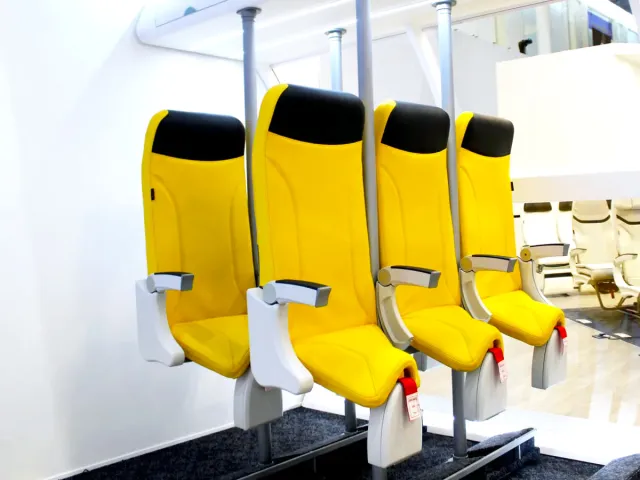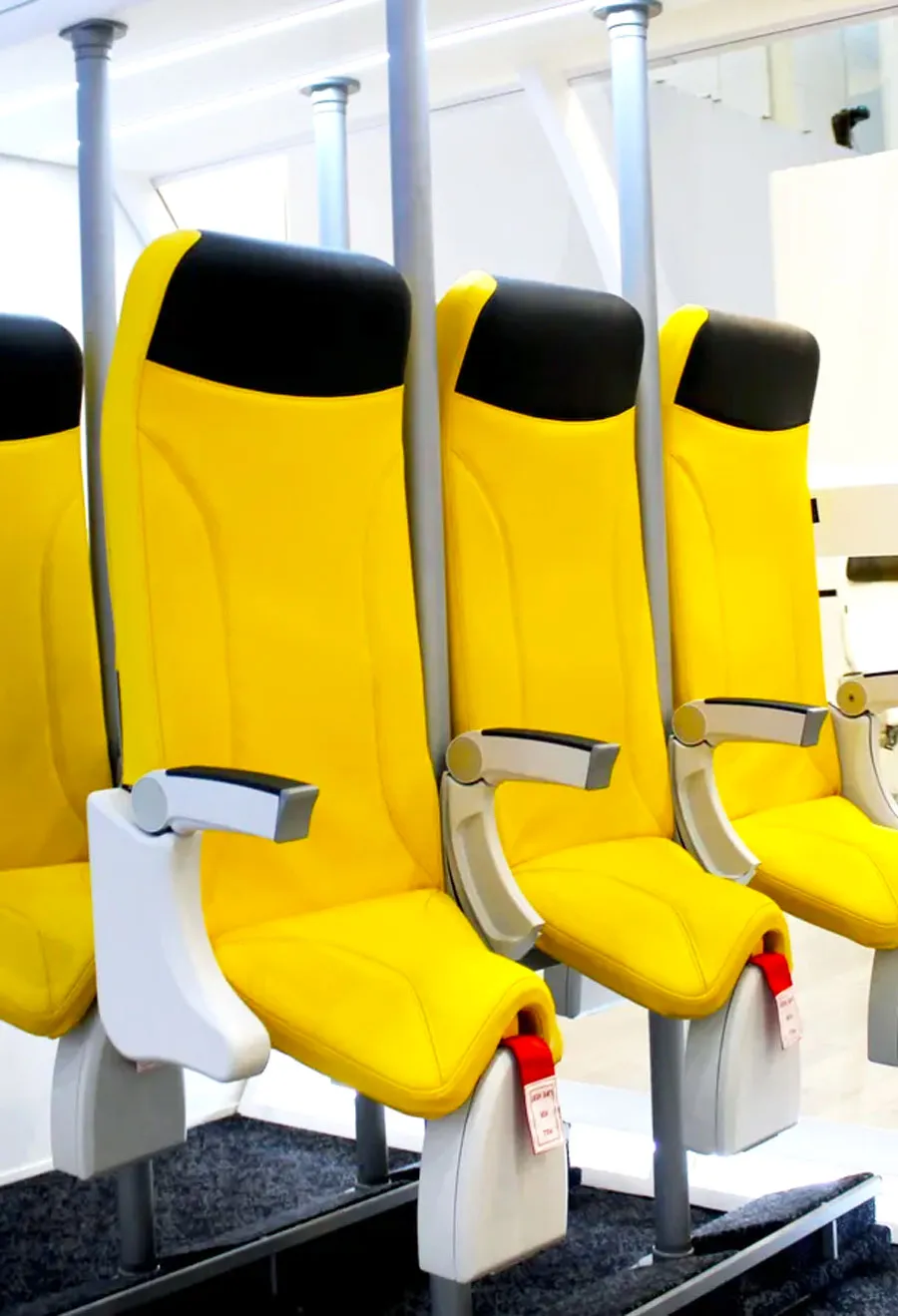Between the narrow seats, limited legroom, and fighting over seat recline, flying for the vast majority of travelers is far from the most comfortable experience these days. But according to recent industry rumblings, things have the potential to become even more uncomfortable in the form of standing-only seats. (Yes, you read that right.) Here’s a closer look at the controversial vertical seat concept and whether or not you should expect them to debut in the near future.
The Skyrider Standing Seat

Photo credit: Image courtesy of Aviointeriors
In 2010, the Italian company Aviointeriors unveiled a concept for a new type of airline seat called the Skyrider. The firm debuted its first prototype in 2012, with the most recent 3.0 version of the seat arriving in 2019. Each chair features a rigid back attached to a small seat cushion that’s similar in nature to a traditional bike seat. Passengers are meant to straddle the seat cushion with their legs hanging over the sides, resulting in a half-standing, half-sitting position. Since the seats aren’t designed to recline, you’ll effectively be upright for the duration of a flight.
The logic behind this design has to do with lessening seat pitch, the distance from one point on a seat to the very same point on the seat behind it. The shorter the pitch, the more seats airlines can theoretically fit into the cabin. Today, the average seat pitch in economy class hovers around 30 inches, but with the Skyrider 3.0, the average pitch can be lowered to just 23 inches.
Aviointeriors claims that these seats would allow airlines to potentially increase cabin capacity by up to 20%, which would likely add to their bottom line. Furthermore, the company notes that the Skyrider 3.0 is 50% lighter than a standard economy-class seat. This means less weight on the aircraft, which results in less fuel consumption. The seats also require less maintenance, which means the planes can spend more time in the air and less on the ground. These cost savings may be compelling for some airlines, even though they come at the expense of customer comfort.
Rumors of a 2026 Debut

Some publications, such as the Daily Mail, have reported that a few low-cost carriers are mulling over the idea of rolling out standing-only seats as soon as 2026. According to Euro Weekly News, the seats would be intended for flights of two hours or less, as their design would make them too uncomfortable for long-haul journeys.
One of the most vocal proponents of standing-only seats is Ryanair CEO Michael O’Leary. Back in 2012, O’Leary proposed a plan to install these seats on his company’s airplanes, which would have bumped up average capacity from 189 seats to 230 seats. At the time, O’Leary suggested that anyone willing to stand would pay a discounted ticket price. That plan never materialized, though similar concepts have been pitched in the 13 years since.
Why You Shouldn’t Be Worried

If you’re worried about standing-only seats popping up on your next flight, you can breathe a sigh of relief — for now. A spokesperson for the European Union Aviation Safety Agency (EASA) told Birmingham Live in May, “In terms of standing seats in aircraft, EASA has yet to have any applications for such an approach nor have we seen any practical use cases because the design of the fuselage does not provide space for standing passengers right across to the window. Any organization applying to use standing seating would face considerable challenges in redesigning aircraft to accommodate them and to demonstrate their ability to meet the safety and evacuation requirements.”
Both the EASA and the Federal Aviation Administration (FAA) require airplane seats to pass dynamic testing that proves they can handle turbulence, and there’s no confirmation that the Skyrider 3.0 seats have undergone this testing yet. It remains to be seen what type of impact these seats would have on the human body in the case of severe turbulence, as the upright position of the seats distributes force in a different manner compared with more traditional airplane seats.
Additionally, the configuration of these standing-only seats may pose complications when trying to evacuate the aircraft, as more people onboard means larger crowds and less mobility. Given that the FAA requires every plane to be evacuable in around 90 seconds, the seats are unlikely to be certified unless those requirements are changed. Furthermore, the configuration of the airplane cabins themselves would likely need to be reconfigured, as the seats are designed in a way that means both the seats and passengers will be higher off the ground and closer to the overhead luggage bins and low cabin ceilings.
All told, if and when certification takes place, it will be a lengthy process, and it remains to be seen whether such seats will ever take to the skies. For what it’s worth, aircraft manufacturer Airbus also filed a patent in 2014 for a fold-down, bicycle-style seat meant to maximize cabin space, but, like the Skyrider, this seat has yet to come to fruition.
But perhaps the most conclusive evidence to dispel these 2026 rumors comes from Aviointeriors itself. The company recently took to its social media pages to issue a statement, sharing, “The Skyrider, often mistaken for a finalized airline seat ready for takeoff, is in fact a conceptual prototype design.” The company added, “For now the Skyrider is not part of the official lineup. But who knows what the future of aviation may hold?”
More from our network
Daily Passport is part of Inbox Studio, which publishes content that uplifts, informs, and inspires.
















